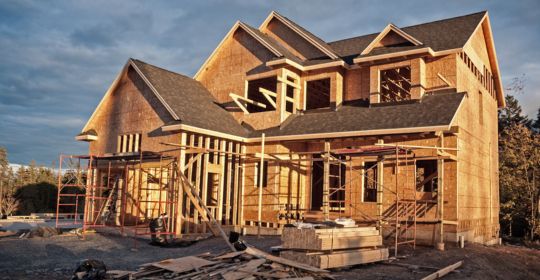
Home Loans
No matter which type of home loan you need, we’ll help to make the whole process easy.
Let us help you find the mortgage option that’s right for you. We offer low-interest rates and flexible terms, tailored to your needs. Our expert team guides you through a seamless application process, helping you every step of the way. Whether you’re a first-time buyer or refinancing, make your homeownership dreams a reality with us.
We make buying, building, or refinancing a home easy and personal. We’ll help you find the perfect option with any one of our home loans.
Whether you’re buying your first home, your next home, or building your forever home, Redstone Bank lenders can help through the entire process. We’ll listen to your needs, walk you through step-by-step what you need to do, and help you celebrate when it’s all said and done. We’re here to help make home loans simple and stress-free.
Ready to get started? Start your loan application online today!
Apply OnlineWhy work with Redstone Bank?

How much home can you afford?
Our mortgage calculator figures out your monthly mortgage payment based on the principle borrowed, loan length, and annual interest rate.
Frequently Asked Questions
What is the process to get a mortgage loan?
Getting a mortgage loan typically involves several steps:
- Financial Assessment: Begin by evaluating your financial situation. Determine your budget, down payment, and how much you can afford as a monthly payment. Midwest Bank’s mortgage lenders are great resources to sit down with and look over your financial assessment and help in any way possible.
- Loan Application: Submit a formal mortgage application to your chosen lender. This will require a credit check and review of your income and assets. Your lender will look at different mortgage programs that fit your specific situation.
- Pre-Approval: Consult with a lender to get pre-approved for a mortgage. This provides approval for a specific property.
- Purchase agreement: Once you have found a home and have signed the purchase agreement, your lender will need a copy. This allows your lender to start preparing early disclosures, lock your interest rate, and gather additional information for your mortgage.
- Sign early disclosures: the early disclosures detail mortgage information, interest rate, down payment, monthly payment estimates, and estimated closing costs. Your signatures on the early disclosures also allow your lender to order and appraisal and request additional verifications needed for your home loan.
- Appraisal: An appraiser assesses the property’s value to ensure that the current market value is equal to or more than the purchase price.
- Underwriting: The lender’s underwriter reviews your credit package and the property appraisal to issue loan approval
- Loan Approval: If approved, the lender issues a commitment letter outlining the terms and conditions.
- Initial Closing Disclosure: These are signed 3 days prior to closing date. The closing disclosure included interest rate, monthly payment, final closing costs, and cash due at closing for down payment and fees.
- Closing: Sign the mortgage documents and pay the down payment and closing costs.
- Homeownership: Congratulations, you become a homeowner and are now responsible for making monthly mortgage payments!
Remember, the mortgage process can vary based on the lender, the type of loan, and local regulations. It’s essential to work closely with a qualified mortgage professional to guide you through the specific requirements and steps for your situation.
What does locking in a rate mean?
A rate lock, in the context of a mortgage loan, is a contractual agreement between the borrower and the lender to secure a specific interest rate for a defined period. This agreement ensures that the interest rate on the mortgage remains unchanged, regardless of any fluctuations in market interest rates during the lock period.
Should I refinance my home?
Refinancing your mortgage can be a smart financial move, potentially saving you money on your monthly mortgage payment or on total interest over the life of your loan. You’ll also want to decide if refinancing makes sense financially by weighing any money you’ll save against the cost of the refinancing the loan.
- Lower Interest Rate: General rule of thumb says to refinance your mortgage if your new rate is 1% or more below your current rate.
- Improve credit score: Your credit is a significant factor in determining your mortgage rate. Generally, the better your credit is, the lower the interest rate you’ll receive. If your credit has improved since securing your home loan, it is worth looking to see if you can refinance to a lower interest rate.
- Shorter loan term: If you’re looking to pay your mortgage down quickly, you may want to refinance to a shorter loan term. You’ll find additional savings if you can secure a lower interest rate and shorten your term. A shorter loan term means you’ll pay less in total interest, but you’ll probably be increasing your monthly payment in exchange, so make sure it fits into your budget.
- Increased home value: If the value of your home has gone up, you might also get some benefit from refinancing, especially if you have paying Private Mortgage Insurance (also known as PMI). If you purchased a home and did not have 20% or more down payment, you are likely paying PMI as part of your monthly payment. If you home value has increased, you can refinance your mortgage and potentially lower or completely remove PMI from your monthly payment. Generally, you would be looking to have your loan amount compared to home appraised value or LTV to be under 80% to remove PMI.
- Cash out refinance: A cash-out refinance allows you to take out a loan amount that’s larger than what you previously owed on your original mortgage, and you receive the difference in cash. A cash-out refi is an alternative to a home equity loan. You also might consider a cash-out refi for home improvements, consolidating other debts, or to pay for a child’s education.
What is the difference between appraisal and a whole house inspection?
An appraisal and a whole-house inspection are separate processes when purchasing a property. An appraisal primarily assesses the property’s market value, aiming to provide a lender with assurance that the property is worth what the buyer has agreed to pay. In contrast, a whole-house inspection is a thorough evaluation of the property’s physical condition conducted on behalf of the buyer. It delves into the structural, mechanical, and safety aspects of the property, identifying any existing issues or potential concerns. While an appraisal is essential for securing financing, a whole-house inspection empowers the buyer with critical information about the property’s condition, helping them make an informed decision and negotiate repairs or adjustments with the seller. Both processes play vital roles in the homebuying journey but serve different purposes.
We’re here to help
We’re here to help you through the process. Reach out to our team and we’ll help you get started today.
Call your local branch
When you call us, you’re going to get to talk to a real person. We promise.
Get in touchContact us online
Reach out to us online and we’ll get you a response as soon as possible.
Contact usRelated Resources
All resources
Personal Credit Cards
With a variety of different credit card types to choose from, Redstone Bank has the perfect card for you and your family. Our cards can help you gain financial freedom while building your credit and also earn valuable rewards.
Learn more
Refinancing Your Home
Refinancing your mortgage can help you lower your monthly payment, shorten your loan term, or even allow you to get cash out. Sit down with our lenders to discuss your refinancing options and if it’s the right choice for you and your family.
Learn more














